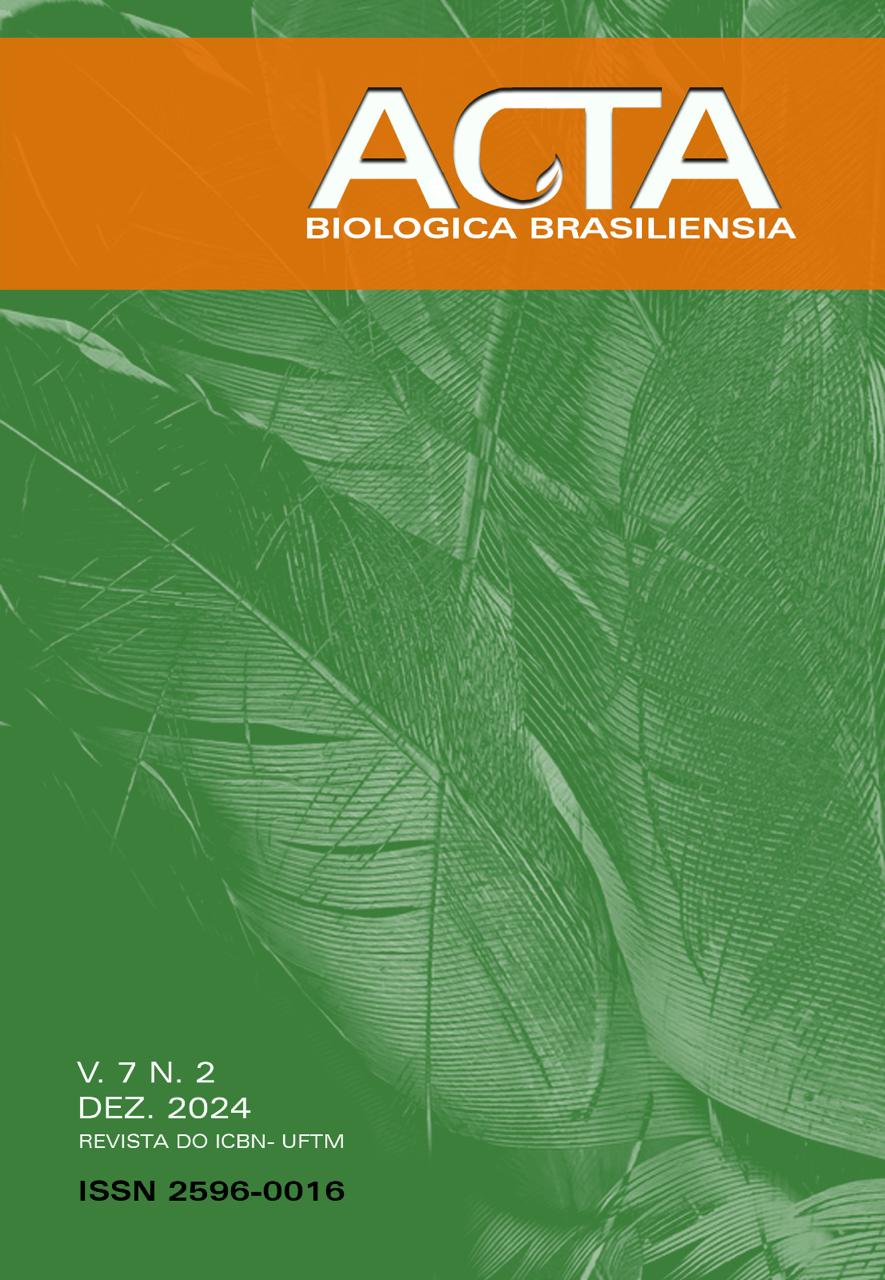RELAÇÃO ENTRE RELIGIÃO, ESPIRITUALIDADE E SAÚDE:
PROBLEMÁTICAS E AVANÇOS
DOI:
https://doi.org/10.18554/acbiobras.v7i2.7896Keywords:
traditional sabers, ethnobotany, quality of lifeAbstract
This article aims to understand the relationship between religion, spirituality, and health, considering their influence on individuals' quality of life. The historical context is presented to support its relevance today, which includes the pharmaceutical industry, the population's habits, and their way of dealing with health. The methodology used consists of an exploratory study of the literature in the scientific databases Google Scholar, Scielo, Pubmed, and digital scientific journals. For this, 26 descriptors were used, in addition to Boolean operators, from 2008 to 2024. The research indicated a strong correlation between religion, spirituality, and health maintenance in Brazil since the colonial era, highlighting the prevalence of human interaction with the natural environment in its practices, knowledge, and beliefs. Arising from medicines, rituals, or daily habits, the prevalence of traditional knowledge, mixed with customs of certain beliefs and religious matrices, were the basis of several studies that determined their scientific proof regarding their health benefits. Furthermore, the study highlights that ethnobotany, when combined with the appreciation of traditional knowledge, plays a fundamental role in promoting public policies to maintain the physical and mental health of the population. Certain challenges still exist for the integration of health and religion, such as religious alienation and resistance to adherence to medical treatments and preventive measures. Furthermore, it is clear that it is important to increase Brazil's visibility and participation in the development of scientific research that uses medicinal plants for the pharmaceutical industry, as it is one of the countries with the greatest potential for biodiversity in the world. Building a good quality of life is closely related to spirituality, as it shapes behaviors in a way that influences one's lifestyle and the way one deals with physical and psychological illnesses. The difficulty in finding specific scientific articles highlights the neglect of the subject today. The topic addressed, therefore, proved to be of utmost importance for the treatment of the population in a humane manner, regardless of their religiosity and spirituality, and for the recognition of the contribution of traditional knowledge to maintaining health
References
Falbel N. Judeus no Brasil: Estudos e Notas. São Paulo: Edusp; 2008.
Ribeiro JO. Sincretismo religioso no Brasil: uma análise histórica das transformações no catolicismo, evangelismo, candomblé e espiritismo. Universidade Federal de Pernambuco. 2012.
Martins RWA, Clarindo AO, Campos MM. Bruxas, curandeiras e benzedeiras: existências e resistências. Revista Mosaico. 2023; 15(23): 201–25. https://doi.org/10.12660/rm.v15n23.2023.88865.
Romão TLC. Sincretismo religioso como estratégia de sobrevivência transnacional e translacional: divindades africanas e santos católicos em tradução. Trabalhos em Linguística Aplicada. 2018; 57(1): 353–81. https://doi.org/10.1590/010318138651758358681.
Andrade WM. O interesse fitoterápico no Brasil: colônia e império. Tema: História da Ciência, Brasil Colônia, Brasil Império. 2015.
Bicalho C. A imagem na arte verbal Maxakali: aspectos de uma poética de pajelança. Galáxia. 2018; (39): 88–109. https://doi.org/10.1590/1982-255435537.
Gaudêncio JS, Rodrigues SPJ, Martins DR. Indígenas brasileiros e o uso das plantas. Khronos. 2020; (9): 163–82. https://doi.org/10.11606/khronos.v0i9.171134.
Leite BMB. Boticas, boticários e cultura farmacêutica nos estabelecimentos da Companhia de Jesus no "Estado do Brasil". 1670-1759. Boletim do Museu Paraense Emílio Goeldi Ciências Humanas. 2022; 17(1): e20200130. https://doi.org/10.1590/2178-2547-BGOELDI-2020-0130.
Rodrigues AP, Andrade LHC. Levantamento etnobotânico das plantas medicinais utilizadas pela comunidade de Inhamã, Pernambuco, Nordeste do Brasil. Revista Brasileira de Plantas Medicinais. 2014; 16(3): 721-30. https://doi.org/10.1590/1983-084x/08_159.
Presidência da República (BR). Decreto nº 5813, de 22 de junho de 2006. Aprova a Política Nacional de Plantas Medicinais e Fitoterápicos. D.O.U, Brasília, DF, 22 jun 2006. https://www.planalto.gov.br/ccivil_03/_ato2004-2006/2006/decreto/d5813.htm.
Ministério da Saúde (BR). Relação nacional de medicamentos essenciais. Brasília: Ministério da Saúde; 2022.
Patrício KP, Minato AC dos S, Brolio AF, Lopes MA, Barros GR de, Moraes V, et al. O uso de plantas medicinais na atenção primária à saúde: revisão integrativa. Ciência & Saúde Coletiva. 2022; 27(2): 677-86. https://doi.org/10.1590/1413-81232022272.46312020.
Franken R, Cosentino SF, Zadra M, Colomé IS dos S, et al., O uso de plantas medicinais e de medicamentos fitoterápicos na atenção básica à saúde. In: Sarturi F, da Silva LAA, Martins RV, ed.: Gestão de organização pública em saúde: aproximando saberes. Santa Maria: UFSM, NTE, UAB, 2017, p. 93-106.
Ministério da Saúde (BR). Formulário de Fitoterápicos. Brasília: Ministério da Saúde; 2021.
Skirycz A, Kierszniowska S, Méret M, Willmitzer L, Tzotzos G, et al. Medicinal bioprospecting of the Amazon rainforest: a modern Eldorado? Trends in Biotechnology. 2016; 34(10): 781-90. https://doi.org/10.1016/j.tibtech.2016.03.006.
Harvey AL, Edrada-Ebel R, Quinn RJ. The re-emergence of natural products for drug discovery in the genomics era. Nature reviews drug discovery. 2015; 14(2): 111-29. https://doi.org/10.1038/nrd4510.
Mendes CG, Fraga AGM, Silva NV da, Alvarez MOO, Assunção AB dos S, Santos NJ de L, et al. Abordagem da religiosidade e espiritualidade na atuação profissional do farmacêutico: desafios para grupo de pesquisa. Research, Society and Development. 2022; 11(14): e138111436202. https://doi.org/10.33448/rsd-v11i14.36202.
Martins AM, Soares AKS, Arruda GO de, Baptista CJ, et al. Association between religion, mental health and social distancing during the COVID-19 pandemic. Psico-USF. 2023; 28(1): 79-90. https://doi.org/10.1590/1413-82712023280107.
Bardi G, Garcia MLT. Comunidades terapêuticas religiosas: entre a salvação pela fé e a negação dos seus princípios. Ciência & Saúde Coletiva. 2022; 27(4): 1557-66. https://doi.org/10.1590/1413-81232022274.05152021.
Dias AC. Religião e saúde: uma contribuição evangélica. Revista Pistis & Praxis: Teologia e Pastoral. 2010; 2(1): 127-43.
Dias AM, Azeredo BA. Depressão e religiosidade uma busca pelo equilíbrio farmacêutico e espiritual. Unitas: revista eletrônica de Teologia e Ciências das Religiões. 2020; 8(1): 54-68.
Alves RR da N, Alves H da N, Barboza RRD, Souto W de MS, et al. The influence of religiosity on health. Ciência & Saúde Coletiva. 2010; 15(4): 2105-11. https://doi.org/10.1590/S1413-81232010000400024.





